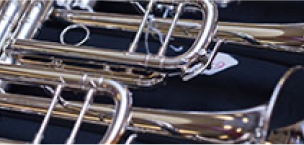Immediate Care for Water Damaged Instruments
Musical instrument maintenance is integral to the proper playing condition
of every instrument, as well as the future success of the player. Sometimes
an unforeseen event occurs that incites immediate care of your instrument
no matter how well it has been previously maintained. If your instrument
has experienced any exposure to water or wet conditions, quick and immediate
action must be taken. Though we have included steps to follow to help lessen
water based damage, do not hesitate to bring your instrument to The Repair
Shop to have it evaluated*. Our Professional repair technicians can review
your instrument and provide you with a Free Estimate for repairs needed
to restore your instrument into playing condition. Most water damaged instruments
will require professional cleaning and repairs to be returned to playing
condition.
Keep in Mind:
- Estimates are always FREE at Music & Arts
-
TIME IS OF THE ESSENCE!
- Mold grows quickly in wet, dark places
- Fast action increases the likelihood that your instrument can be repaired
-
Not all instruments and/or cases can be saved
- If the worst case scenario occurs, our highly knowledgeable sales staff can help find the best replacement option for you
*The steps shown below are provided as a first step of care only. Music
& Arts recommends that all water damaged instruments be evaluated by
your local instrument repair technician to ensure that your instrument
is safe to play.
Brass Instruments
-
Check for Mold
- If no mold is present move to step 2
- If mold is present or you are unsure of its presence STOP
- Place the instrument in a plastic bag and bring it to The Repair Shop for a Free Estimate
- Remove instrument from case See “Cases” section for case maintenance
- Remove all of the Valves and Slides
- Give a bath using warm water, dish soap and a cleaning snake
- Use shop vac, hair dryer or fan to remove excess moisture
- Oil Valves and place them in the corresponding valve casing
- Grease the tuning slides and return them to the proper location
- Wipe down the exterior of the instrument with a soft cloth
- Do not return to the case until both the instrument and case are completely dry†
Note:
French Horns and other rotary valve instruments will need to be disassembled
and serviced by an instrument repair technician. This is due to the closed
valve system that is inherent of all rotary valve instruments.
Woodwind
-
Check for Mold
- If no mold is present move to step 2
- If mold is present or you are unsure of its presence STOP
- Remove instrument from case See “Cases” section for case maintenance
- Use a Swab to remove moisture from the interior of the instrument
- Wipe down the exterior of instrument with a soft cloth
- Use shop vac, hair dryer, or fan to remove any remaining moisture
- Apply oil to key mechanism to prevent hinge rods from rusting
- Do not return to the case until both the instrument and case are completely dry†
Note:
Woodwind instrument pads, corks, & felts are highly sensitive to water
damage; it is recommended that all woodwind instruments exposed to water
or extreme moisture are evaluated by an instrument repair technician.
String Instruments
-
Check for Mold
- If no mold is present move to step 2
- If mold is present or you are unsure of its presence STOP
- Remove instrument from case a. See “Cases” section for case maintenance
- Release string tension a. Remove bridge, tailpiece and strings
- Use a soft cloth to wipe excess moisture off of the exterior of the instrument
- Lay out in an area with a fan circulating air around it
- Do not return to the case until both the instrument and case are completely dry†
Note:
String instruments are highly sensitive to water damage. It is recommended
that all string instruments exposed to water or extreme moisture are evaluated
by an instrument repair technician.
Percussion
-
Check for Mold
- If no mold is present move to step 2
- If mold is present or you are unsure of its presence STOP
- Remove instrument from case See “Cases” section for case repair
- Loosen tension on Drum heads
- Wipe down instrument
- Use shop vac, hair dryer, or fan to remove excess moisture
-
Once dry:
- Disassemble instrument (Please contact a repair technician if you do not feel comfortable doing this)
- Lubricate any moving parts to prevent rusting
- Reassemble instrument & tune
- Do not return to case until both the instrument and case are completely dry†
Note:
Contact your local repair technician for details on drying out specific
percussion instruments
Cases
- Use a shop vac to remove excess moisture
-
Lay open in the sun or position a fan to circulate air around it
- † In most cases it will be safer and more economical to replace the case than reuse the water damaged one



